hankyoreh
Links to other country sites 다른 나라 사이트 링크
[Reportage] More and more babies with disabilities being abandoned

By Kim Hyo-jin, staff reporter
Joon-hoo cried as needles pierced both of his legs. On Jan. 6, he had just had his first birthday and was laid on a bed in an infant intensive care unit in Seoul Metropolitan Children’s Hospital, where he had been for 11 months. Injections may now be somewhat bearable, but not the hunger Joon-hoo had to deal with: he couldn’t eat because of his high fever.
Joon-hoo, who was born with a rare congenital disease, seemed fine for a while after being transferred to the rehabilitation ward from the intensive care unit (ICU) last July. Suddenly, his temperature rose to 39.5 degrees early this month. He had to be sent back to the ICU after having been in a recovery ward for six months. He couldn’t swallow baby food, which meant he couldn’t eat because any piece of food could block his esophagus and cause him to suffocate.
Joon-hoo was abandoned in the ‘baby box’ in Jusarang Church in Seoul one month after he was born. Notes left with him expressed worry. “He was born on Jan. 24, 2013 with a rare disease. He has a lot of health problems. He can’t drink powdered milk well but he needs to be fed in every three hours.” Joon-hoo’s disease is called Rubinstein-Taybi syndrome and is caused by a chromosomal abnormality. Joon-hoo could only stare at the ceiling while other children were being sent to long-term care facilities, such as children’s homes, through the Seoul Metropolitan Children’s Welfare Center.
Both Joon-hoo’s thumbs are round and flat like pestles, which is a symptom of his disease. His left middle and ring fingers are attached, and there is paddle-shaped flesh in between his right middle and ring fingers. Rubinstein-Taybi syndrome is a disease that only one out of more than a hundred thousand people gets. When Joon-hoo was a newborn, nurses had difficulties taking care of him because he couldn’t drink milk without vomiting. He couldn’t move his head during the first three months of his life. In his fourth month, nurses were relieved. He now can move and can turn over on his own.

Seoul Metropolitan Children’s Hospital accommodates 20 critically ill infants. Six of them, including Joon-hoo, are from the baby box; they have no parents and are not affiliated with any institutions. They zone out at 3 pm and 8 pm when the other babies’ parents come to visit. They do nothing but look at the other children being served by their own parents, who stroke their babies’ faces and wipe their saliva. Among the six babies, some might be discharged and sent to Seoul Metropolitan Children’s Welfare Center after being treated for jaundice. Some might be completely cured after having cleft palate surgery. However, a few like Sae-jin and Yoon-ha, are in precarious situations, not knowing when they’ll leave or where they’ll end up after their time in this facility. Sae-jin can’t even be diagnosed because she is a premature baby; she was born only after 27 weeks in utero. Yoon-ha’s body became stiff and she was diagnosed with periventricular leukomalacia.
One of the nurses said, “At least babies from the baby box don’t fall unconscious and aren’t hospitalized for long. Parents who abandon their babies at the baby box do so because they think there is some hope of saving the baby. Parents abandon their children because they expect us to look after them. They don’t abandon babies that they think will die soon.” Nurses hold 100-day celebration parties and write baby books for the baby box babies. In the baby book, they keep the copied notes from the parents, babies’ footprints, handprints, and even belly button pictures attached.
Gwanak District Office takes babies from the baby box to the hospital every Monday and Thursday, so the nurses get nervous on those days. Usually, 20 beds in the unit are all occupied, but when a new baby arrives and needs urgent treatment, one of the inpatient babies has to leave for another facility. In the worst case, even babies who are sick are sent either to the rehabilitation ward or Seoul Metropolitan Children’s Welfare Center first, and are rehospitalized later when there is a bed available.
Twelve nurses work in three shifts and are more concerned about the babies than their heavy workload. “We have not been able to hospitalize unconscious babies with a guardian because the number of baby box babies has increased. We would like to take care of them for as long as possible, but have to let them go once they get better. It is unfortunate that we just have too many babies to look after with only a few nurses”.
Due to the increase of babies abandoned at the baby box, there are more that need health checks before being sent to Seoul Metropolitan Children‘s Welfare Center. Only 23 babies were examined in 2011. That number rose to 70 in 2012 - a more than threefold increase in two years. Last year, 204 babies were examined. Most of them were sent to temporary institutions after undergoing a basic examination. However, over the past three years, 75 babies have had to be hospitalized with Down syndrome, jaundice and brain conditions. 21 of them are still in Seoul Metropolitan Children’s Hospital.
Beds are usually full. 220 out of 236 are occupied. One inpatient baby owes an average of 2 million won (US$1,882) per month to the hospital. Baby box babies with no guardian have to bear the total cost. A member of the hospital staff said, “The number of baby box babies skyrocketed between 2012 and 2013. There is a chance we might get more beds, but we are worried. We always prepare under the assumption that we will have 10% more babies than we had last year.”
The names of the children in this article have been changed to protect their identities
Translated by Kim Hae-yoon, Hankyoreh English intern
Please direct questions or comments to [english@hani.co.kr]

Editorial・opinion
![[Guest essay] The real reason Korea’s new right wants to dub Rhee a founding father [Guest essay] The real reason Korea’s new right wants to dub Rhee a founding father](https://flexible.img.hani.co.kr/flexible/normal/500/300/imgdb/original/2024/0423/8317138574257878.jpg) [Guest essay] The real reason Korea’s new right wants to dub Rhee a founding father
[Guest essay] The real reason Korea’s new right wants to dub Rhee a founding father![[Column] ‘Choson’: Is it time we start referring to N. Korea in its own terms? [Column] ‘Choson’: Is it time we start referring to N. Korea in its own terms?](https://flexible.img.hani.co.kr/flexible/normal/500/300/imgdb/original/2024/0423/3617138579390322.jpg) [Column] ‘Choson’: Is it time we start referring to N. Korea in its own terms?
[Column] ‘Choson’: Is it time we start referring to N. Korea in its own terms?- [Editorial] Japan’s rewriting of history with Korea has gone too far
- [Column] The president’s questionable capacity for dialogue
- [Column] Are chaebol firms just pizza pies for families to divvy up as they please?
- [Column] Has Korea, too, crossed the Rubicon on China?
- [Correspondent’s column] In Japan’s alliance with US, echoes of its past alliances with UK
- [Editorial] Does Yoon think the Korean public is wrong?
- [Editorial] As it bolsters its alliance with US, Japan must be accountable for past
- [Guest essay] Amending the Constitution is Yoon’s key to leaving office in public’s good graces
Most viewed articles
- 1[Column] ‘Choson’: Is it time we start referring to N. Korea in its own terms?
- 2Senior doctors cut hours, prepare to resign as government refuses to scrap medical reform plan
- 3[Guest essay] The real reason Korea’s new right wants to dub Rhee a founding father
- 4Why Korea shouldn’t welcome Japan’s newly beefed up defense cooperation with US
- 5[Column] The clock is ticking for Korea’s first lady
- 6Opposition calls Yoon’s chief of staff appointment a ‘slap in the face’
- 7New AI-based translation tools make their way into everyday life in Korea
- 8Terry Anderson, AP reporter who informed world of massacre in Gwangju, dies at 76
- 9Korean government’s compromise plan for medical reform swiftly rejected by doctors
- 10[Editorial] Japan’s rewriting of history with Korea has gone too far